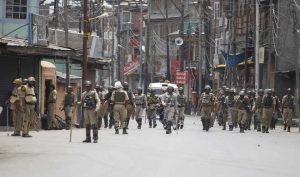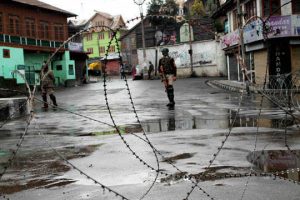Peace Watch » Editor's Take, Kashmir-Talk, Perspectives » Srinagar is Not ‘Ghetto People’: Story of Collective Punishment of Downtown
Srinagar is Not ‘Ghetto People’: Story of Collective Punishment of Downtown
Punchline
They Are Not ‘Ghetto People’
Z.G.Muhammad
 Honestly, they ‘have been more sinned against than sinning.’ Distraught at the plight of a million people with bright minds and deft hands this Shakespearean quote knocked my mind while walking through the streets, lanes, and bylanes of the heart of Srinagar city. None but the people they catapulted to power after big struggle and sacrifices have betrayed them and made them powerless. Their collective story is akin to the tragedy of King Lear. Caught up in the storm, they have been ‘crying upon heavens to execute justice’ and ‘invoking the “dreadful summoners”—the gods who tend to judgment and retribution.’
Honestly, they ‘have been more sinned against than sinning.’ Distraught at the plight of a million people with bright minds and deft hands this Shakespearean quote knocked my mind while walking through the streets, lanes, and bylanes of the heart of Srinagar city. None but the people they catapulted to power after big struggle and sacrifices have betrayed them and made them powerless. Their collective story is akin to the tragedy of King Lear. Caught up in the storm, they have been ‘crying upon heavens to execute justice’ and ‘invoking the “dreadful summoners”—the gods who tend to judgment and retribution.’ 
The pain inflicting on them by euphemistically naming them as people of the “five-police-station” thus ghettoizing them is writ on their faces. Hurting, the pride of these people is hurting the very ethos of Kashmir. I doubt those who for past a decade and a half have been endeavoring hard to ghettoize the people living in the historic part of the metropolis understand its dynamics. Perhaps, the majority of them have no idea about them- their history and resilience.
The city on the banks of the Jhelum, for about five hundred years, was the hub of scholarship and nerve center of the Kashmir economy. It shot into prominence as an important trading center for the Central Asian states and China in the 14th century when the Sultans of Kashmir established their capital on the right bank of Jhelum. Many a boarding colleges and a university for scholars from Persia and Central Asia were set up in the capital city. History testifies, some occasional travelers trickled through high mountain passes from the neighboring countries into our land, and 4th Buddhist Conference was held here before also, nevertheless, it made in a big way to the tourist map after the 13th century. It turned into the biggest haven of the best woolens and handicrafts after the arrival of the Syed Ali Hamadani and his caravan. It was he who brought softest wool pashmina to Kashmir and presented it to Sultan Qutab-u-Din, who got it manufactured into a Shawl. Handicrafts industry, because of the royal patronage became a mass movement, every Mohalla in the capital city now nicknamed downtown buzzed with manufacturing activity. The skillful hands of Kashmiris breathed life in every inanimate product. The close interaction with Central Asia opened the international market for the product. The handicrafts manufactured in the narrow lanes and small Mohallas of the City became a passport for traders of the state to reach to European and Chinese markets. The master artisans and craftsmen, now ghettoized through much orchestrated “dominant discourse” have been the pillars of the economy of Kashmir, as well as icons of the prosperity of the land.

SRINAGAR, NOV 18 (UNI)- A road at Rajouri Kadal blocked by the security personnel with concertina as they are enforcing curfew like restrictions imposed by authorities in several parts of in down town Srinagar, like Shar-e-Khas and in the areas falling under Parimpora police station as a precautionary measure on Saturday. UNI PHOTO-109U
It is indisputable that in olden times it was not the geo-strategic importance of our land but the affluence that invited invaders and marauders. Some rapacious neighbor for big money from the handicrafts looked at Kashmir as a goose laying golden eggs. After invading the country, they appointed most cruel governors for exacting taxes from every shawl manufactured and every artisan- and filling their coffers in Delhi, Kabul and Lahore. Of all the taxes imposed on the people particularly the artisan those by the Maharajas after 1846, were brute of all. On 6th July 1847, there was a first uprising against the cruel tax system 4000 weavers from the city aka Downtown Srinagar started their march towards Lahore, to complain to the British Resident. Because of the intervention of a British and conceding some demands they returned. 29th April 1865, is another significant milestone in the resistance movement, thousands of shawl weavers on this day had risen in revolt against the tax system of the Maharaja. Twenty-eight downtowners killed on this day. For, their vested interest the Maharajas wanted the handicrafts industry to survive and grow. It survived and flourished during 1931, freedom struggle when Kashmir was perpetually under turmoil. In the first half of the twentieth century, the state earned substantial foreign exchange from handicrafts and silk. During the world war exports of Kashmir woolens more particularly the rugs mostly manufactured in the old city touched the peak. The then administration despite people having revolted against the Maharaja did not indulge in collective punishment of the people. It did not kill the handicrafts sector- the mainstay of the overwhelming majority of the old city, the epicenter of the movement. In the most disturbing situation, when tourism came to naught, it has been the handicrafts exports mainly from the old city that has kept the state economy afloat.
Nevertheless, for the punitive policies of the state towards the historic city with many artisans under economic pressures have abandoned their traditional vocations resulting in the death of some crafts from gold engraving to precious stone polishing. Many creative artisans have switched over to some alternative menial occupations. Deathly silence is prevailing in scores of karkhanas of woodcarvers, silver engravers, weavers even carpet makers that immensely contributed to export trade of the state and earned foreign exchange.
Since, the times of Maharaja Ranbir Singh, who was installed by his father Gulab Singh in 1856, it is for the first time that the economy of the Downtown has come under direct attack. Using coercive tactics, he closed the market around the Jamia Masjid that from the days of the construction of the Masjid in 14th century buzzed with commercial activities. Instead, he set up a new market for traders from Punjab in Maharaj Gunj and Kashmir traders were made to play second fiddle. For past, one-decade it is not only the artisans and craftsmen that have received an economic setback, but entire commercial activities have been adversely hit- making many traders close their business or shift to other markets. Since 2008, the administration has adopted a typecast policy of placing the downtown under curfew euphemistically called as restrictions. In the recent past the downtown markets, which are known as low markup market had become shoppers’ paradise attracting clientele from posh colonies. A reporter of this newspaper has indicated that at an average rupees one hundred crore business is lost in a couple of markets around the Jamia Masjid in one day of curfew. The political situation in the historical and heritage city is not different from other parts of the state; it is not a political ghetto that deserves to be isolated and looked from a different prism. There is a need to do away with the five-police- station-syndrome invented during the PDP-Congress coalition government. The government needs to revisit its policy towards the downtown and allow space for reviving its economy.
Filed under: Editor's Take, Kashmir-Talk, Perspectives







